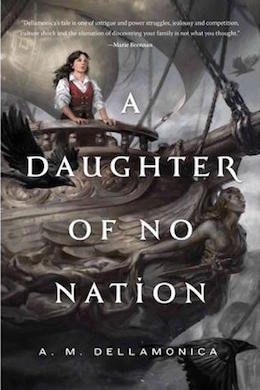In Child of a Hidden Sea, adventurer and biology enthusiast Sophie Hansa is transported to Stormwrack, a world of island nations ruled by swashbuckling and magic. She finds herself embroiled in a political conflict involving members of a family she never knew she had, and quickly realizes that Stormwrack isn’t just an exciting playground for her to explore. In fact, it may hold important warnings about the future of her own world. After a series of high-stakes escapades involving deep sea diving, dueling, and murder, she is forced to return home to San Francisco with far more questions than answers.
A Daughter of No Nation picks up months later. Sophie has been hard at work, improving her stamina, learning knot-tying techniques and self-defense, and generally making herself into the best potential Stormwrack explorer that she can be. When her half-sister Verena turns up and asks her to go back to Stormwrack, Sophie jumps at the chance to return.
Verena wants Sophie’s help securing freedom—or at least bail—for their mother, who has been jailed for hiding the fact of Sophie’s existence from her father, Cly Banning, chief Duelist-Adjudicator and potential psychopath. Sophie agrees to spend some quality time with him and travel to his home island in order to learn more about the culture that should have been her birthright, in exchange for his assistance. Her anxieties about his character deepen, even as he encourages her scientific exploration and the application of forensics to Stormwrack’s judicial system. She once again finds herself deeply embroiled in a convoluted series of legal disputes, scams, and grudges, torn between the urge to protect the people she loves and the desire to explore and understand a new world.
Much like Sophie herself, I left the first book in this series thoroughly enchanted by the world of Stormwrack but frustrated at the number of questions left unanswered. As such, I was pleased to discover that the sequel doesn’t mess around: twelve pages in, we’re back in Stormwrack, knee-deep in intrigue. I appreciate a sequel that knows what its readers want, and A Daughter of No Nation definitely knows that we want more swashbuckling sea battles, more wacky biology, and more smoldering Captain Parrish, ASAP.
One of the things I loved about the first book was the enthusiasm and detail given to Sophie’s exploration of Stormwrack’s flora and fauna. If you liked its otter island and spider breeding, you’ll love the sequel’s invasive plant species and turtle migrations. The natural world is a part of Stormwrack’s cultures in a way that is often lacking in fantasy novels, and it provides realistic roots for both the magic and social systems.
We also get to see more of the world, with expeditions to new locations and a more detailed portrait of a place where not everyone agrees on what is right and what is wrong. Sophie and her brother Bram inch a bit closer to an understanding of how Stormwrack relates to Earth, and as they do so, we are treated to one of my favorite devices to appear in potential far-future narratives: hints of folklore about our own present and/or future. A flood story that echoes our own mythology but is actually in reference to some future catastrophic event? Yes, please!
Sophie continues to be an engaging character to follow: smart, capable, and a little bit self-centered. This book deepens her relationships with Bram, Verena, Cly, and Garland Parrish as she tries very hard to do the right thing without compromising her passions and morals.
If I have a complaint about this book, it is that it needs even more Captain Parrish. Sophie spends much of the book confused about the status of their relationship, and keeping him at arm’s length as a result. This is a world that in many ways operates on the same level as an old Hollywood movie, and I feel like this relationship would benefit from a little more of that glamour and full-on romance, rather than the more restrained and realistic exchanges we are offered. Don’t get me wrong: their connection is very sweet and charming, but the first book had some swash-unbuckling, as it were, and I will admit that I was hoping for more.
The plot of this book is more meandering than that of the first one, and at times, some of the background shenanigans felt a little hard to invest in. Ultimately, it didn’t really matter that much, because the delight of these stories is definitely in the world building, derring-do, and charming characters, and A Daughter of No Nation delivers all of that and more. It closes with Sophie committing further to a life in Stormwrack, and I am right there with her. I eagerly await the next book.
A Daughter of No Nation is available December 1st from Tor Books.
Read an excerpt from the novel here on Tor.com
Caitlyn Paxson is a writer and storyteller. She is an editor at Goblin Fruit, and can sometimes be found discussing folklore and pop culture on the Fakelore Podcast or performing with the Banjo Apocalypse Crinoline Troubadours.










